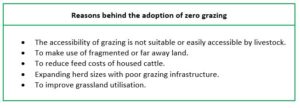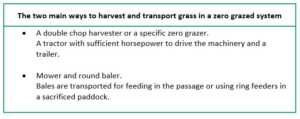Zero grazing is a system where the grass is harvested and fed fresh to housed cattle on a daily basis. It allows farms to increase fresh grass utilisation and milk yield from grass/forage where that farm may not have the infrastructure to graze cattle. Particularly during times of lower milk price, additional fresh grass intake can help to reduce feed costs.

Zero grazing is dynamic – it can work alongside conventional systems if appropriate management is in place.
Feeding Management
- Flexibility and grassland management: crucial when implementing a zero-grazing system, it is important to have adequate supplies of fresh grass available for the cows, therefore forward planning and organisation is key! In order to keep grass fresh, cutting a minimum of twice a day is advised, ensuring that spoilage is kept to a minimum (heating of the cut grass can lead to reduced intakes and animal performance).
- Quality: As good as conventional grazed grass. Harvesting should be done at slightly higher than grazing cover; cover of 3,200 – 3,500kg DM/ha which can ensure quality and yield.
- Space: Reiterating cow signals, ensuring cows have enough space promotes intakes and performance. To ensure intakes are maximised, monitor wastage levels. The refused feed should be removed daily (this will decompose rapidly). Zero grazing units should aim to get less than 5% wastage.
- Silage: Swards which have exceeded grazing cover should be cut out of the rotation and used for silage.
Monitoring quality
Maximising performance and animal health requires regular monitoring. Grass quality can be measured through NIR analysis, which will highlight any adjustments which may be required in the current ration.
*The NWF lab can test fresh grass samples, with a 24-hour turnaround*
How much grass is needed?
Possible daily intakes: 75-100kg of fresh grass/cow/day, DM intake of 14-16kg/day if good grassland management is achieved. Example:

Zero grazing provides the opportunity to cut at higher grass covers (>3,500 kg DM/ha), which would be challenging in a grazing system. However, in a study conducted by AFBI NI, emphasised the effect grass cover has on cow performance.it was found that aiming to maintain zero-grazing grass covers below 3500kg DM/ha will improve both grass utilisation and animal performance.
Supplementary feeding
Similar yield responses should be seen, as with grazing. If fresh grass is dryer then there may be higher silage substitution rates so beware of over buffering and feed wastage. If fresh grass is mixed with silage buffer, the mix can become unpalatable therefore top dressing is recommended. Ensure minerals are balanced, particularly magnesium.
Feed rates should be similar to a grazing situation.
Machinery and Labour
To harvest and transport grass to cows, there is a higher reliance on labour and machinery on a zero-grazing system.

Contingency planning
Through good management and practice, farms should have a contingency plan in place; zero-grazing is no different.

A zero grazing system must be flexible which can account for the unexpected: machinery breakdown and periods of extreme weather.
Limitations
- Some research has shown that the zero-grazing farms performed significantly worse from an ecological and economic point of view due to the less efficient use of concentrates and byproducts.
- Labour and machinery requirements may add cost.
- Infrastructure for the cows and slurry management if housing is increased.
Summary
- Grassland management skills and flexibility are key to zero-grazing systems, entry covers are critical.
- Daily intakes can be up to 16kg DM/h/d, however, may be far lower due to availability and buffering.
- There is a higher emphasis on labour and machinery and therefore cost.
- The utilisation of swards and less favourable fields can be improved.
- Increased forage utilisation due to duel forages being fed can be achieved.
- Consider the time of cutting, grass in the afternoon will have higher sugars, lower free nitrogen and fibre.
- Ensure zero grazed grass older than 12 hours is disposed of due to degradation and heating.
- Balance minerals, particularly magnesium to avoid deficiencies.
For more information or to order NWF Grass Seeds online, click HERE.
Source: Morrison, Greenmount College, 2003|Elgersma et al., 2006| AFBI, 2018

